Flowering Trees
by Valerie (November 1, 2002)
revised May 27, 2003
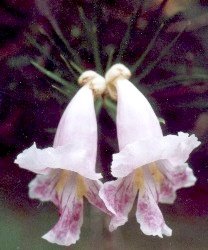 I've written about other trees in our yard that flower, but here are three more that deserve attention. Actually, just about all our trees produce blossoms at one time or another. The species discussed here are all smaller plants with very attractive flowers.
I've written about other trees in our yard that flower, but here are three more that deserve attention. Actually, just about all our trees produce blossoms at one time or another. The species discussed here are all smaller plants with very attractive flowers.
One tree with which I've had terrible luck is the desert willow (Chilopsis linearis). Native to the area west of us, it is a small willow with the usual long, slender leaves. The impressive thing is the blossoms. They are large, pink and white, and appear in profusion in the spring. Once the tree is established, it can handle drought conditions very well and prefers full sun. The catch is getting it started. I've easily germinated seeds three years in a row now. If left in the ground, the seedlings shrivel up during the first hot weather and die. The next time I tried leaving them in pots. Most of them shriveled up and died when I forgot to water them. Except for a couple that were eaten by slugs. They also died. This past summer, I started another batch and kept a couple alive throughout the summer, but they barely grew at all. Then they just sort of shriveled up and died. I suspect I will have to buy a plant that is already large enough to survive if I want one in the gardens.
The sennas are a group of plants that vary greatly in size, but their flowers all look the same: they are yellow with five petals. We have a small tree-sized one called Argentine senna (Cassia corymbosa or Senna corymbosa). A native of Argentina, Brazil and Uruguay, other names for this plant are common tree senna, yellow senna, yellow cassia, flowery senna and Argentine wild sensitive plant (although the leaves never react like those of true sensitive plants). Once again, I had no luck with germinating the seeds so I bought a small plant. It grew rapidly, acquiring three main trunks and a height of about 7 feet. The tree is quite attractive, with dark, finely grained bark, long slender leaves, and bright yellow flowers in the early summer. |
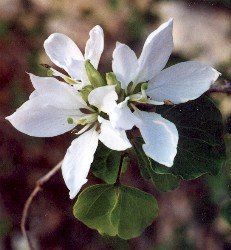
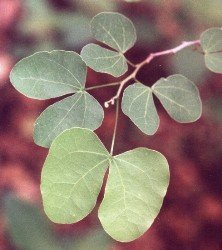 Unable to start the Anacacho orchid tree (Bauhinia lunarioides or B. congesta) from seed, I went ahead and bought a small plant. This is a native in this area, but is not particularly common. It is planted in a rather shady area but is doing quite well and has been blooming for the past few years. The tree is only about four feet tall. It is a very unusual looking plant because its leaves have two symmetrical lobes. The blossoms are white and last for quite some time in the spring. Seed pods always form, but, as I mentioned earlier, I've never gotten any of the seeds to germinate.
Unable to start the Anacacho orchid tree (Bauhinia lunarioides or B. congesta) from seed, I went ahead and bought a small plant. This is a native in this area, but is not particularly common. It is planted in a rather shady area but is doing quite well and has been blooming for the past few years. The tree is only about four feet tall. It is a very unusual looking plant because its leaves have two symmetrical lobes. The blossoms are white and last for quite some time in the spring. Seed pods always form, but, as I mentioned earlier, I've never gotten any of the seeds to germinate.
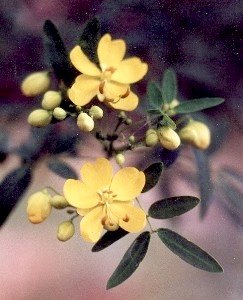
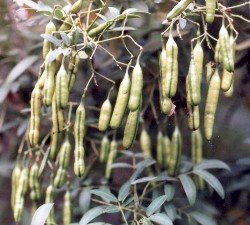 Afterwards, it produces plenty of seed pods, but these are often infested with insect larvae. Two years ago, several of the top branches died during the winter. This was followed by an entire trunk dying during a period of heavy rains which lasted almost a month in the early summer. Part of the tree continued to look just fine, but I had to prune off quite a number of branches as they succumbed. Two healthy trunks with a reduced number of branches survived through last summer but this past winter, one of the trunks died. The remaining trunk has a small group of branches which are still healthy.
Afterwards, it produces plenty of seed pods, but these are often infested with insect larvae. Two years ago, several of the top branches died during the winter. This was followed by an entire trunk dying during a period of heavy rains which lasted almost a month in the early summer. Part of the tree continued to look just fine, but I had to prune off quite a number of branches as they succumbed. Two healthy trunks with a reduced number of branches survived through last summer but this past winter, one of the trunks died. The remaining trunk has a small group of branches which are still healthy.